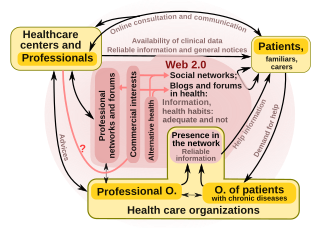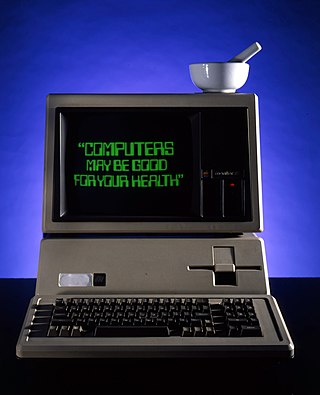
Epidemiology is the study and analysis of the distribution, patterns and determinants of health and disease conditions in a defined population.
In a support group, members provide each other with various types of help, usually nonprofessional and nonmaterial, for a particular shared, usually burdensome, characteristic. Members with the same issues can come together for sharing coping strategies, to feel more empowered and for a sense of community. The help may take the form of providing and evaluating relevant information, relating personal experiences, listening to and accepting others' experiences, providing sympathetic understanding and establishing social networks. A support group may also work to inform the public or engage in advocacy.

Health On the Net Foundation (HON) was a Swiss not-for-profit organization based in Geneva which promoted a code of conduct for websites providing health information and offered certificates to those in compliance.
eHealth describes healthcare services which are supported by digital processes, communication or technology such as electronic prescribing, Telehealth, or Electronic Health Records (EHRs). The use of electronic processes in healthcare dated back to at least the 1990s. Usage of the term varies as it covers not just "Internet medicine" as it was conceived during that time, but also "virtually everything related to computers and medicine". A study in 2005 found 51 unique definitions. Some argue that it is interchangeable with health informatics with a broad definition covering electronic/digital processes in health while others use it in the narrower sense of healthcare practice using the Internet. It can also include health applications and links on mobile phones, referred to as mHealth or m-Health. Key components of eHealth include electronic health records (EHRs), telemedicine, health information exchange, mobile health applications, wearable devices, and online health information. These technologies enable healthcare providers, patients, and other stakeholders to access, manage, and exchange health information more effectively, leading to improved communication, decision-making, and overall healthcare outcomes.
James Edgar Till is a University of Toronto biophysicist, best known for demonstrating – with Ernest McCulloch – the existence of stem cells.
A personal health record (PHR) is a health record where health data and other information related to the care of a patient is maintained by the patient. This stands in contrast to the more widely used electronic medical record, which is operated by institutions and contains data entered by clinicians to support insurance claims. The intention of a PHR is to provide a complete and accurate summary of an individual's medical history which is accessible online. The health data on a PHR might include patient-reported outcome data, lab results, and data from devices such as wireless electronic weighing scales or from a smartphone.
Public health surveillance is, according to the World Health Organization (WHO), "the continuous, systematic collection, analysis and interpretation of health-related data needed for the planning, implementation, and evaluation of public health practice." Public health surveillance may be used to track emerging health-related issues at an early stage and find active solutions in a timely manner. Surveillance systems are generally called upon to provide information regarding when and where health problems are occurring and who is affected.
Thomas William "Tom" Ferguson was an American medical doctor, educator, and author. He was an early advocate for patient empowerment, urging patients to educate themselves, to assume control of their own health care, and to use the Internet as a way of accomplishing those goals.
WebCite is an on-demand archive site, designed to digitally preserve scientific and educationally important material on the web by taking snapshots of Internet contents as they existed at the time when a blogger or a scholar cited or quoted from it. The preservation service enabled verifiability of claims supported by the cited sources even when the original web pages are being revised, removed, or disappear for other reasons, an effect known as link rot.
An e-patient is a health consumer who participates fully in their own medical care, primarily by gathering information about medical conditions that impact them and their families, using the Internet and other digital tools. The term encompasses those who seek guidance for their own ailments, and the friends and family members who research on their behalf. E-patients report two effects of their health research: "better health information and services, and different, but not always better, relationships with their doctors."
The Journal of Medical Internet Research is a peer-reviewed open-access medical journal established in 1999 covering eHealth and "healthcare in the Internet age". The editors-in-chief are Gunther Eysenbach and Rita Kukafka. The publisher is JMIR Publications.

"Health 2.0" is a term introduced in the mid-2000s, as the subset of health care technologies mirroring the wider Web 2.0 movement. It has been defined variously as including social media, user-generated content, and cloud-based and mobile technologies. Some Health 2.0 proponents see these technologies as empowering patients to have greater control over their own health care and diminishing medical paternalism. Critics of the technologies have expressed concerns about possible misinformation and violations of patient privacy.
Health 3.0 is a health-related extension of the concept of Web 3.0 whereby the users' interface with the data and information available on the web is personalized to optimize their experience. This is based on the concept of the Semantic Web, wherein websites' data is accessible for sorting in order to tailor the presentation of information based on user preferences. Health 3.0 will use such data access to enable individuals to better retrieve and contribute to personalized health-related information within networked electronic health records, and social networking resources.
Infoveillance is a type of syndromic surveillance that specifically utilizes information found online. The term, along with the term infodemiology, was coined by Gunther Eysenbach to describe research that uses online information to gather information about human behavior.

The Wikipedia online encyclopedia has, since the late 2000s, served as a popular source for health information for both laypersons and, in many cases, health care practitioners. Health-related articles on Wikipedia are popularly accessed as results from search engines, which frequently deliver links to Wikipedia articles. Independent assessments have been made of the number and demographics of people who seek health information on Wikipedia, the scope of health information on Wikipedia, and the quality and reliability of the information on Wikipedia.
Knowledge translation (KT) is the activities involved in moving research from the laboratory, the research journal, and the academic conference into the hands of people and organizations who can put it to practical use. Knowledge translation is most often used in the health professions, including medicine, nursing, pharmaceuticals, rehabilitation, physical therapy, and public health.

Health information on the Internet refers to all health-related information communicated through or available on the Internet.
Infodemiology was defined by Gunther Eysenbach in the early 2000s as information epidemiology. It is an area of science research focused on scanning the internet for user-contributed health-related content, with the ultimate goal of improving public health. Later, it is also defined as the science of mitigating public health problems resulting from an infodemic.
Participatory surveillance is community-based monitoring of other individuals. This term can be applied to both digital media studies and ecological field studies. In the realm of media studies, it refers to how users surveil each other using the internet. Either through the use of social media, search engines, and other web-based methods of tracking, an individual has the power to find information both freely or non freely given about the individual being searched. Issues of privacy emerge within this sphere of participatory surveillance, predominantly focused on how much information is available on the web that an individual does not consent to. More so, disease outbreak researchers can study social-media based patterns to decrease the time it takes to detect an outbreak, an emerging field of study called infodemiology. Within the realm of ecological fieldwork, participatory surveillance is used as an overarching term for the method in which indigenous and rural communities are used to gain greater accessibility to causes of disease outbreak. By using these communities, disease outbreak can be spotted earlier than through traditional means or healthcare institutions.
An infodemic is a rapid and far-reaching spread of both accurate and inaccurate information about certain issues. The word is a portmanteau of information and epidemic and is used as a metaphor to describe how misinformation and disinformation can spread like a virus from person to person and affect people like a disease. This term, originally coined in 2003 by David Rothkopf, rose to prominence in 2020 during the COVID-19 pandemic.





